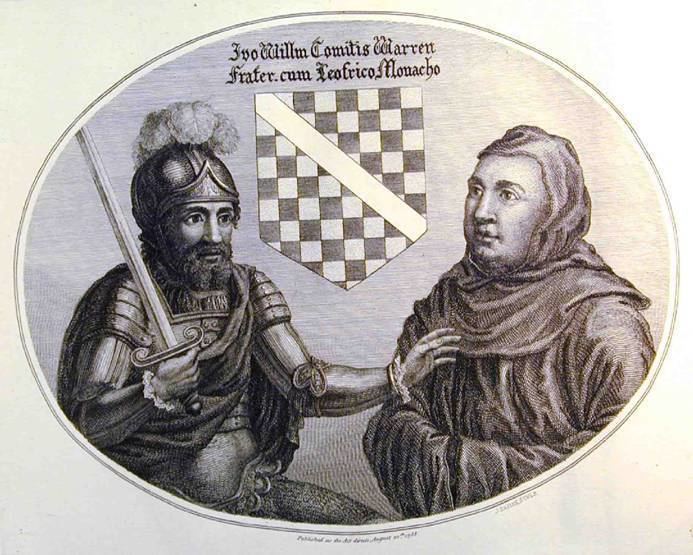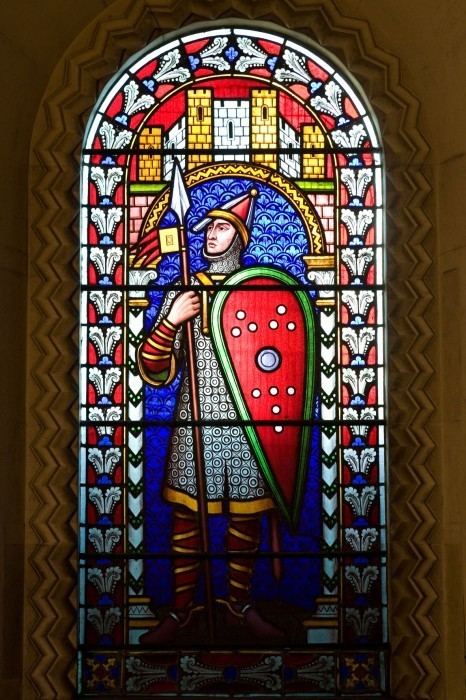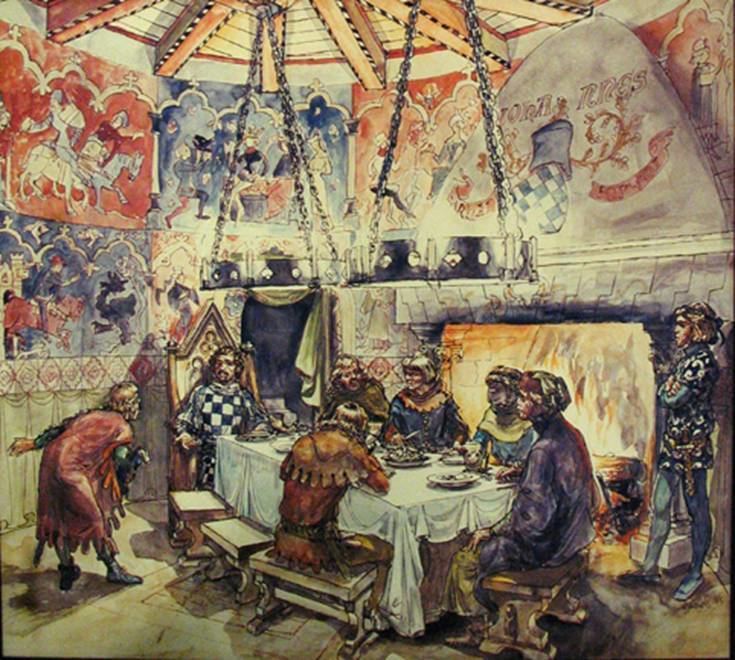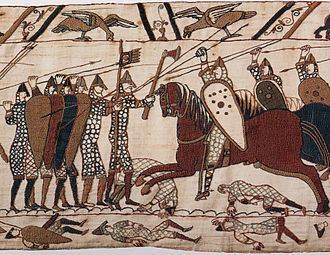Tenure 1088 Name William Warenne, | Structures Lewes Castle | |
 | ||
Parents Ranulf I de WarenneBeatrice Died June 24, 1088, Lewes, United Kingdom Children William de Warenne, 2nd Earl of Surrey Grandchildren Reginald de Warenne, William de Warenne, 3rd Earl of Surrey, Ada de Warenne Great grandchildren Isabel de Warenne, Countess of Surrey Partner Gundred, Countess of Surrey Similar Richard I of Normandy, Robert of Torigni, Orderic Vitalis | ||
Lewes Castle Built In 1069 Fortification. The Barbican. William de Warenne 1080HD
William de Warenne, 1st Earl of Surrey, Lord of Lewes, Seigneur de Varennes (died 1088), was a Norman nobleman created Earl of Surrey under William II Rufus. He is among the few who are documented as having fought for William the Conqueror at the Battle of Hastings in 1066. At the time of the Domesday Survey, he held extensive lands in 13 counties including the Rape of Lewes in Sussex, now divided between the ceremonial counties of East Sussex and West Sussex.
Contents
- Lewes Castle Built In 1069 Fortification The Barbican William de Warenne 1080HD
- Early career
- Conquest of England
- Later career
- Family
- Issue
- References

Early career

William was a son of Rodulf or Ralph de Warenne and Emma, and reported to have descended from a sibling of duchess Gunnor, wife of duke Richard I. Chronicler Robert of Torigny reported, in his additions to the Gesta Normannorum Ducum of William of Jumièges, that William de Warenne and Anglo-Norman baron Roger de Mortimer were brothers, both sons of an unnamed niece of Gunnor. Unfortunately, Robert's genealogies are somewhat confused, (elsewhere he gives Roger as son of William, and yet again makes both sons of Walter de Saint Martin), and several of Robert's stemma appear to contain too few generations. Orderic Vitalis describes William as Roger's consanguineus, literally "cousin", more generically a term of close kinship, but not typically used to describe brothers, and Roger de Mortimer appears to have been a generation older than William de Warenne.

Charters report several earlier men associated with Warenne. A Radulf de Warenne appears in two charters, one dated between 1027 and 1035, the second from about 1050 and naming his wife, Beatrice. In 1059, a Radulf and wife Emma appear along with their sons Radulf and William. These occurrences have typically been taken to represent a single Radulf with successive wives, of which Beatrice was the mother of William and hence identical to the Gunnorid niece described by Robert de Torigny, yet the 1059 charter explicitly names Emma as William's mother. Reevaluation of surviving charters led Katherine Keats-Rohan to suggest that, as he appears to have done elsewhere, Robert of Torigny compressed two generations into one, with Radulf (I) and Beatrice being parents of Radulf (II) de Warenne and of Roger de Mortimer (a Roger son of Radulf de Warenne appears in a charter dated 1040/1053), and Radulf (II) in turn married Emma and as attested by the 1059 charter, they had Radulf (III), the heir in Normandy, and William. Associations with the village of Vascœuil led to identification of the Warenne progenitrix with a widow Beatrice, daughter of Tesselin, vicomte of Rouen, appearing there in 1054/60. Robert of Torigny shows a different vicomte of Rouen to have married a niece of Gunnor, perhaps suggesting that it was through Beatrice that William de Warenne was linked with Gunnor's family.

William was from the hamlet of Varenne, near to Arques-la-Bataille, Duchy of Normandy, now in the canton of Bellencombre, Seine Maritime. At the beginning of Duke William’s reign, Radulf de Warenne was not a major landholder, and as a second son, William de Warenne did not stand to inherit the family’s small estates. During the rebellions of 1052–54, the young William de Warenne proved himself a loyal adherent to the Duke and played a significant part in the Battle of Mortemer for which he was rewarded with lands confiscated from his kinsman, Roger of Mortemer, including the Castle of Mortimer and most of the surrounding lands. At about the same time he acquired lands at Bellencombre including the castle which became the centre of William de Warenne’s holdings in Normandy.
Conquest of England
William was among the Norman barons summoned to the Council of Lillebonne by Duke William when the decision was made to oppose King Harold II's accession to the throne of England. He fought at the Battle of Hastings and was well rewarded with numerous holdings. The Domesday book records his lands stretched over thirteen counties and included the important Rape of Lewes in Sussex, several manors in Norfolk, Suffolk and Essex, the significant manor of Conisbrough in Yorkshire and Castle Acre in Norfolk, which became his caput (see below). He is one of very few proven companions of William the Conqueror known to have fought at the Battle of Hastings in 1066. He fought against rebels at the Isle of Ely in 1071, where he showed a special desire to hunt down Hereward the Wake, who had killed his brother-in-law Frederick the year before. Hereward is supposed to have unhorsed him with an arrow shot.
Later career
Sometime between 1078 and 1082, William and his wife Gundred traveled to Rome visiting monasteries along the way. In Burgundy they were unable to go any further due to a war between Emperor Henry IV and Pope Gregory VII. They visited Cluny Abbey and were impressed with the monks and their dedication. William and Gundred decided to found a Cluniac priory on their own lands in England. William restored buildings for an abbey. They sent to Hugh, the abbot of Cluny, for monks to come to England at their monastery. At first Hugh was reluctant but he finally sent several monks, including Lazlo who was to be the first abbot. The house they founded was Lewes Priory, dedicated to St. Pancras, the first Cluniac priory in England.
William participated in the siege of Saint-Suzanne, supporting the king against some rebellious lords. William was loyal to William II, and it was probably in early 1088 that he was created Earl of Surrey. He was mortally wounded at the First Siege of Pevensey Castle and died 24 June 1088 at Lewes, Sussex, and was buried next to his wife Gundred at the Chapterhouse of Lewes Priory.
Family
He married first, before 1070, Gundred. sister of Gerbod the Fleming, 1st Earl of Chester.
William married secondly a sister of Richard Gouet, who survived him.
Issue
By Gundred, William had:
He had no issue by his second wife.
